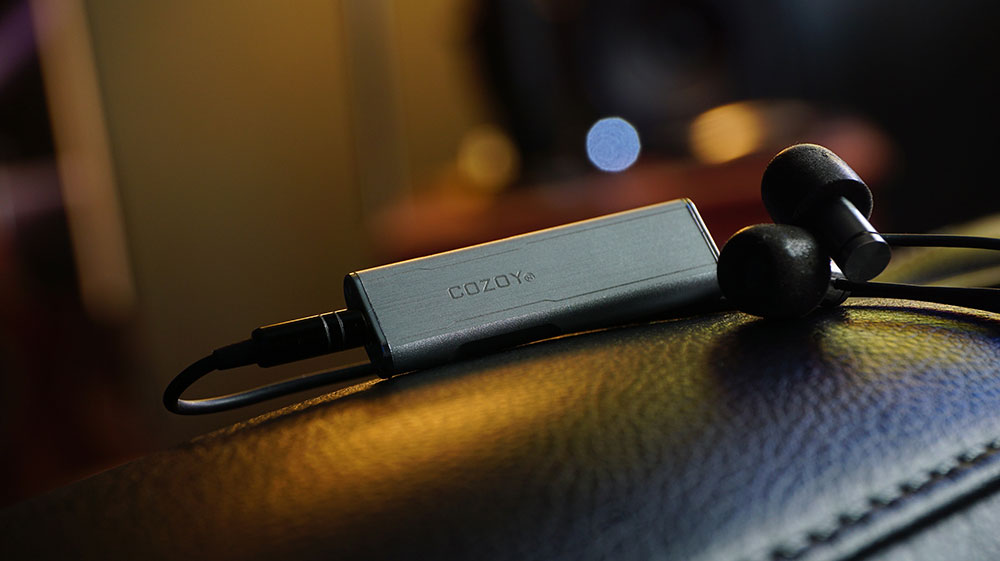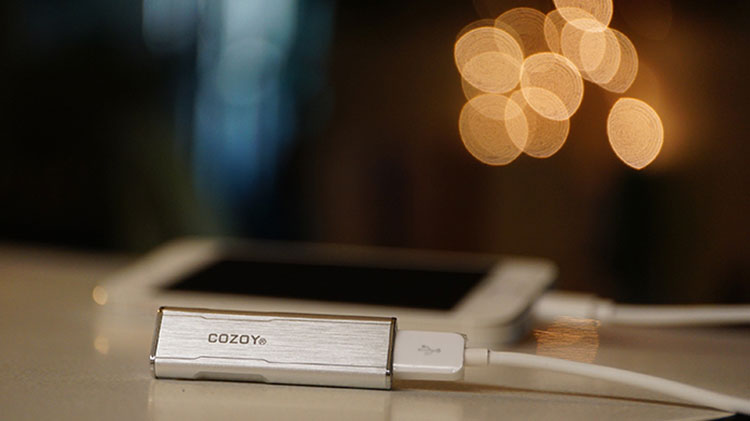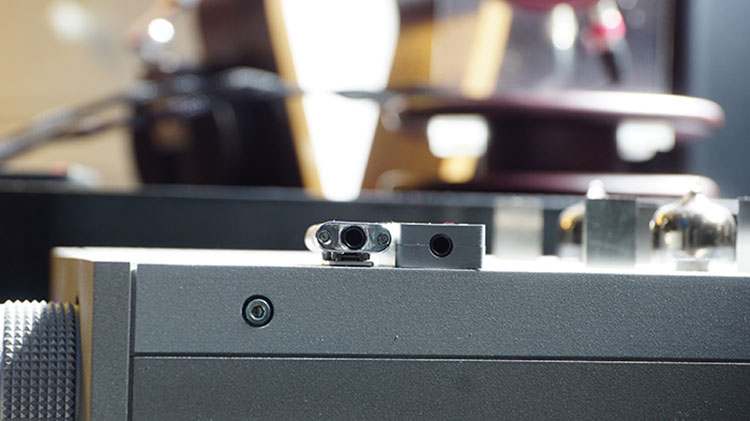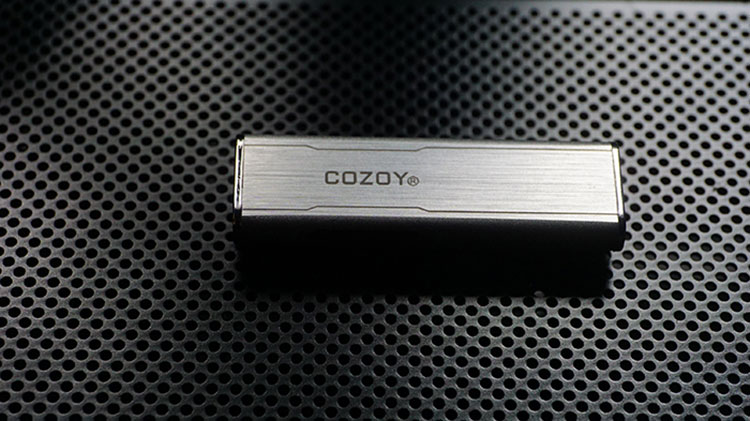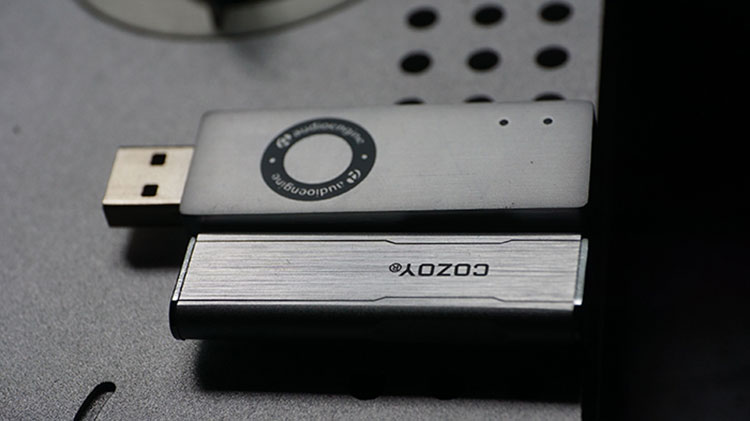The Cozoy Astrapi is a small USB/DAC portable dongle designed to work with iOS and Android using OTG. It is priced at $129.90.
Disclaimer: The Cozoy Astrapi sent to us is a sample in exchange for our honest opinion. We thank Cozoy for this opportunity.
To learn more about portable amp & DAC reviews on Headfonics you can click here.
Oh my goodness, it’s so cute! Sorry, but I am a sucker for cute things…double points when a cool design in a product actually ends up sounding nice. This Asian company released the Alien Dap not too long ago, which was also awesomely designed and it seemed as though most of the community really enjoyed it.
I’ve not heard Cozoy’s Alien portable player yet, but after hearing their Astrapi…I may have to try to get my hands on their portable music player if it indeed sounds anything like the Astrapi.
Form Factor
I’d previously thought the Audio Engine d3 was the pinnacle of tininess in a DAC design, but I was so wrong. Cozoy’s Astrapi is the smallest DAC that I’ve ever reviewed and I just can’t get over how small it really is, as well as what else it has to offer the audio world.
This little bugger is not only a solid middle-tier USB DAC for the PC but also a line out for apple products as well. iPad and iPhone enthusiasts should be paying attention right now…you’re salvation has arrived.
I’d just recently reviewed the CEntrance Mini M8, which costs almost $700 and I’d found it to house some serious issues with usage via the PC. True, the Mini M8 used with Lightning output resulted in excellent sound and features, but the PC end of its ability was severely broken and lacking support for common things we’ve come to consider basic rights.
The USB Cable
The Astrapi comes with a standard mini USB to USB cable, a Lightning cable for Apple products and a normal mini to mini USB cable. As small as the design is, it really bothers me when I use it with my Alienware laptop.
It seems the extra cable length really negates the size of the product; it is so small to begin with but when you tack on the cable needed to bridge it to a PC, you are left with a product that might as well have a USB lead on it like the Audio Engine D3 has.
This problem isn’t so severe with cell phone usage via the line out, but you’ll need to buy a short cable or else be stuck with a long 6 inch cable that bridged your iPhone to the Astrapi. It really is unsightly to strap a long cable like that to a small phone, which in turn is connected to the tiny Cozoy device.
When all is said and done, the Astrapi delivers a very nice sound. Finally, Apple users can get really nice quality on the go without shelling insane cash out for the CEntrance Mini M8 or the older line out DAC’s used for apple iPod’s back in the day.
Thankfully, things don’t need to be so large and bulky these days just to digitally output Apple tunes to a DAC, then convert back to analog for your headphone.
Power needs
Seems the Astrapi isn’t at all geared for anything beyond 32ohm, as it doesn’t have the juice to get the job done on most efficient, full-sized headphones in general. Portaphiles will be happy with the results, especially so if you are a budget to mid-tier IEM user.
There are no physical dials on the Astrapi, it’s a pure DAC and you won’t get any volume control or fancy bass booster buttons, but you will get a nice and firm voltage swing for most efficient portables and IEMs alike.
Sound Impressions
Bass and Phone DAC
True, there isn’t much going on down below but I feel the bass experience of this Cozoy Astrapi to offer a bit more fidelity than the Audio Engine D3 I am so used to. Plugging it into my Audio Engine A5+ speaker’s results in a noticeably cleaner sound when I swap outputs via Foobar: swinging from the Audio Engine D3 to the Astrapi with the press of one hotkey. Ah, thank God for Foobar, makes my job so easy sometimes.
Anyhow, the texture seems to be relatively flat and neutral, also in desperate need of some oomph via a bass booster if you ask me. Then again, I am not into the total flat quantity thing from top to bottom, I prefer a bit more elevated bass levels and I think people who own bookshelf speakers would want more thickness to the low end. Thankfully, the Astrapi responds nicely to some of Foobar’s bass boosting EQ presets and I feel more than satisfied in bass quantity needs.
Bass Quantity
You really aren’t going to want to purchase the Astrapi if you are using headphones with solid bass quantity and don’t have access to a good source that it pairs with. Amazingly enough, the Astrapi pairs with the Apple iPhone but I feel the iPhone to lack any decent audio controls by comparison to something like the Android phones or the insane number of EQ apps over yonder in the Droid Market.
If you aren’t willing to shell out a few bucks for a good music app, then skip this. If you have something decent already installed, go for it. I can’t really think of any other product this clean that bypasses the iPhone DAC and subs it with something a hell of a lot nicer.
Bass heads aren’t going to like this, but casual listeners are in for a nice treat with this Astrapi. Quantity is a problem for me on a personal level, but only because I like more oomph than the general consumer. Sadly, the Astrapi offers more of a balanced sound signature with a lacking bass quantity by comparison to the mid and treble offered beyond it.
Vocals
Things really got interesting here for me on a personal level. I’d previously found the Audio Engine D3 to be more than sufficient to power my Audio Engine A5+ speakers in terms of a nice, solid and weighted feel to the midrange, but now I think I’ve finally found something small that actually outperforms it.
Cozoy’s Astrapi does a very good job as a USB DAC with my pc, outing into my speakers it seems to push more substance and solidity than the D3 from Audio Engine. I really didn’t expect that for such a price, although I have to admit the D3 feels slower, more relaxed on the draw than the Astrapi.
There is definitely a clear difference between the two: the Astrapi is quick on the decay and doesn’t linger and is more pure sounding, the D3 has more of a balanced feel to it and doesn’t dissipate nearly as fast as the Astrapi. Depending on your preferences, either or may suit you…I prefer the D3’s setup and lack of quickness, as I find it tonally more relaxing and smooth, less raw than the Astrapi.
Midrange
When it comes to the midrange in general, I can’t help but to feel there is a lack of smoothness in the Astrapi. As mentioned, the Astrapi is quite raw and even a little gritty sounding when paired with the pc as a USB DAC, thankfully though this really isn’t much of a problem with the apple iPhone output.
PC enthusiasts should be happy with it, as raw clarity isn’t really that far off of the O2 DAC. I’m definitely going to sacrifice the smoothness of my Audio Engine D3 for the Astrapi’s higher clarity factor, but I am sure I will be upset with its lack of a relaxing decay factor.
I am not sure if this is a good thing or a bad thing for those who are looking for a good midrange DAC, most seem to want a soothing and smooth vocal experience: that yummy, liquid-like factor just isn’t as abundant here as it is with the D3.
In turn, this Astrapi may be geared more for the clinical speakers out there or the more budget-oriented headphones that attempted to seize a reference tonality. Warm and colored headphones just don’t pair well with this Astrapi, at least in my opinion.
Speaker Effect
That lack of a slick midrange feel kind of bugs me a little too much when I use the Astrapi with my A5+ speakers, but it has some perks that vary with genre selection. For example: Big Band and Swing don’t really sound so nice through my Audio Engine D3, but they do sound a bit more enjoyable through the Astrapi.
I seem to enjoy Jazz much more through my D3, than with the Astrapi. It is a give and take scenario here, sacrifice will be made with tonal preferences no matter which route you take, but you should feel comfortable knowing clarity as found in the Astrapi is a bit superior to the D3 from Audio Engine, which in turn was just about on par with the Dragonfly.
This Astrapi becomes problematic when I use lower tier, sub $150 headphones and it seems it is better suited for the very lower mid-tier headphones out there in the roughly $200 tier: Focal One, Sony 950BT and similar types mesh better to my ears.
Clarity
Clarity pairing is something I rarely talk about (pairing a DAC/amp with a headphone that is the same price just because they may offer similar sound quality, neither really shooting far above their weight in price to performance) and in this case I have to admit the Astrapi is good, but not great.
Side by side with FiiO’s E17, I really cannot hear much of a difference. When the E17 isn’t being boosted in any way and all EQ is set to a neutral pattern, the Astrapi sounds very similar to me yet also allows you to use it as a source output with Android and iPhone devices. So, in terms of usefulness at least, the Astrapi is leagues above the competition and also offers very nice sound quality as well.
Treble
I consider the treble dry and overly snappy, I am not fond of it. While it has more quantity than the D3 and the E17, I’ve found it to be very problematic with my A5+ speakers, as well as numerous lower tier headphones I was able to test with.
The Astrapi is just a little potent with the treble and as someone who is sensitive to impact up top; I simply avoid songs that I know have some bite in their treble experiences. I can’t really fault this Astrapi for it, but it feels like the treble is a bit more pronounced on the gear I have.
This is something I would prefer to be more relaxed and laid back, more smooth and enjoyable in a tonal sense of the word.
Raw
However, the Astrapi’s upper end is similar to its midrange in that it feels overly raw. The lack of smoothness and finesse upsets me, but considering what this little titan can do…it doesn’t bother me.
No product is perfect and hardly anything else out there offers both USB output for a PC, a form factor this incredibly tiny and also the option to use it as a cell phone DAC as well. With the latter in mind, I just can’t listen to the stock iPhone output with the Astrapi.
By no fault of the Astrapi though, this time it’s the apple device that is the problem. My iPhone 6 just sounds like garbage to begin with and the lack of a sophisticated EQ really makes it that much worse for me. I’ve also heard through the audio enthusiast community that the Astrapi pairs nicely with the Google Nexus 6, so that might be a good option for you to test out for yourselves if you are able.
Pairing
This Astrapi doesn’t pair well with the likes of the Beyerdynamic headphones I own, such as the DT770 Pro or the DT880 32ohm, nor does it pair well with the Focal Professional, Flare R1 or the MrSpeakers Ether.
True, that last one is overkill and shouldn’t be used with it in the first place, but I am a sucker for trying as many combinations of gear as I could muster. The best type of headphone or speaker to use with this Astrapi is one that is regarded for a linear bass and mid experience, but one also with a reserved treble quantity.
The lack of brightness in certain headphones, like my Flare R2Pro IEM for example, really counters the Astrapi’s lustful and somewhat overabundant treble to me ears. You can swing past this with some EQing, but doing so kind of wrecks the decent sound stage the Astrapi offers.
Staging
The Astrapi is reliant on the upper mid brightness and treble for its general spacious feel, which is definitely superior to the D3 from Audio Engine. Instrument separation is good, but not great.
I don’t think AD700 users or Vmoda M100 owners will want to use the Astrapi as their primary USB DAC for a PC, but considering hardly anything this size exists for phone output…I say go for it anyway and enjoy. Sure, the Astrapi isn’t much of a sound staging machine, but it feels well-formed enough for me to consider it a positive experience.
I’ve encountered lots of crappy staging qualities in various other DAC’s in my time and by no means have I yet to feel the Astrapi to offer a poor stereo image. In fact, I think it is rather shapely and similar to the O2 in terms of setup and physicality.
I think that so long as you stay away from certain headphones that offer a very large sound stage to begin with, you’ll enjoy the experience well enough. As a sound stage fan myself, I endorse my own statements twice over with regard to staging properties.
Height & Width
Height and Width are well within the bounds of being acceptable and enjoyable, but stage depth of field is where my biggest gripes are encountered. I feel the D3 and the E17 to offer more of a cavernous feel, but the Astrapi to offer more of a solid, dense and well-formed experience in general.
The D3 and E17 feel artificial depth of field, due solely to their lack of a more realistic and weighted physicality to all vocals and instruments: think less substance, more depth. Those two qualities should never mix together. Thankfully, the Astrapi doesn’t feel thin by comparison to those other DACs, but it does feel more deep and concise.
Pairings
I think this DAC will be a great pairing with some other mid-tier amplifiers out there and my justification or it could be an entire report in and of itself…but I’ll keep that part simple, sweet and to the point.
Due to the abundant substance factor of the Astrapi, as well as the treble quantity, snap and linear-forward sound signature, the Astrapi is almost ideal as the first link in the chain of your middle tier rig. Having something in abundance is always better than not having it and trying to find an amplifier that will boost those qualities you want.
The reverse of that latter part should be how you go about things: let the DAC start off with mostly good qualities. The good DAC will push the good amp to the best of its abilities at all times, whereas the decent DAC combined with a good DAC will always be the link in the chain.
With regard to staging, you want that first link to be as spacious and as high in fidelity as possible before it reaches the amplifier.
Our Verdict
Well damn, it is just adorable to boot…isn’t it? Despite my treble gripes as found in the Astrapi, I think they’ve done a very nice job. I don’t think it will win awards for sound quality, but it deserves recognition for being absurdly well rounded and useful.
I plan to use this as my primary DAC for my speakers, my D3 has become obsolete. However, it really annoys me to have to plug a mini USB cable from my pc to the Astrapi, then run a headphone cable to the Astrapi as well. I’d rather it be like the D3 with an actual USB adapter designed into the chassis, instead of forcing a mini USB to normal USB cable to be used just to connect to the pc.
Minor gripes, I hate having extra cables around. I can’t say that I’ve ever seen a USB DAC this small that functions as a PC DAC as well as an Android/Apple device USB output device. Dang, hope this is the future of sources in general for us and it feels great to know someone out there is thinking of actual portability when it comes to this sort of thing.
In the age of large headphones, smart phones and brick style USB DAC’s, Cozoy’s Astrapi is a refreshing experience that most other companies should be trying to copy. It is solid feeling, well designed and sounds very nice in most areas of listening…can you really ask for more in a chassis this tiny?
Technical Specifications
- Hi-resolution :24Bit-96khz 192khz
- Headphone output :3.5mm
- Impedance :16-100ohm at 1khz loading
- Output vrms:1.5Vrms max
- THD+N:0.003% ,1khz 0dbfs
- SNR:105Db AT 3.3V power supply
- Resolution :24bit/192khz sampling
- System power current :10mA-70mA max
- Power input:1.8V-3.3V+-10%
- Output gain level step :3dB/step ;16 steps
- Headphone power output :10mW max
- Plug type: digital lightning connector
- Cable length:20cm
- Support connectors: Lightning connector .micro usb-micro usb ,micro usb-usb
- Note: it only support great brand mobile phone
Supports:
- iPhone5/6,iPad/iPod mini,iPod touch
- Android (OTG Function)
- PC/Laptop




